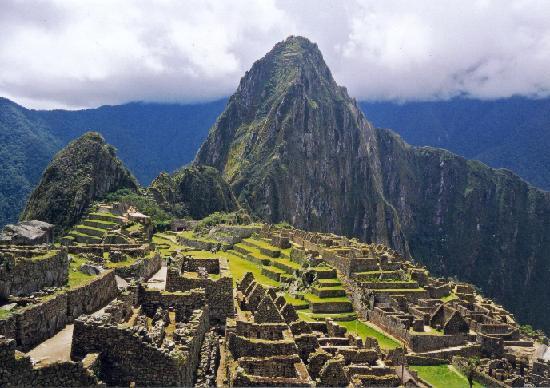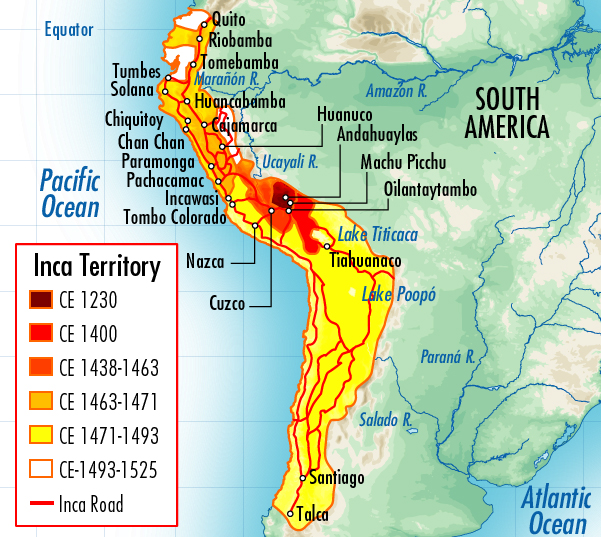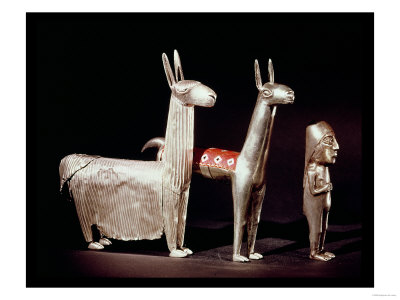The Inca Civilization
Hello, I'm Erica. Today I'm going to be talking about the Inca Civilization, in respects to their government, law systems, economy, and scientific contributions and achievements.
Along the course of this presentation, there will be several historical images and facts. If you are viewing the presentation at home, click the "historical image" text to view them. To navigate through the presentation, click the links in the menu on the left-hand side.

Who are the Inca?
- The Incas are highlanders that ruled in present-day South America between approx. 1000 and 1600 CE.
- It is "believed that their ancestors had emerged from a natural feature of the landscape." (Altroy, 49)
Origins
- 1000 - 2000 CE: The Andean region consists of several isolated communities. The Inca is one of these groups.
- They lived in the highland region, near Lake Titicaca.
- According to myth, the Incas became a civilization when four brothers and sisters - the children of the Sun God - emerged from a cave, called the "House of Windows" (Tampu T'aqo). They left on a journey in pursuit of a suitable settlement, and were followed by their people. After years of searching, only one son, Manqo Qhapaq, remained. He had a golden rod that he frequently plunged into the ground, in search of fertility in the land. When he reached Cuzco, the rod had embedded itself in the ground, indicating fertile land. They decided to stay there, and Cuzco became the homeland and capital of the Inca civilization.
- Manqo Qhapaq became the first Inca ancestor and emperor.
Geography
In terms of geography, the Inca were a people of western South America. This includes present-day Peru, Ecuador, Bolivia, north-west Argentina, and the great part of Chile.
Because of their location, the Inca had three different geographical regions:
- The coastal desert
- The highlands
- The eastern slopes of the Andes
Government
- The Inca government is considered to be very sophisticated, and worked so well that very few civilizations were able to surpass them.
- It was mainly a monarchy where power was passed from father to son.
- It was a very orderly system, and the administration was strictly organized.
Morals and Responsibilities
- Though the government believed that all citizens worked for the state, the government held responsibility for their well-being.
- In fact, government officials often taught citizens how to do jobs (e.g. how to irrigate their fields).
- Officials were also responsible for all those in ranks below them.
- Because of this, they were known as a welfare government.
Overview:
In terms of government, there are three main areas of focus:
- The Sapa Inca (emperor) and Coya (sister-wife).
- The political structure and hierarchy.
- The administrative system and levels of authority.

The Sapa Inca and Coya

The Sapa Inca
- Means "Supreme Inca"; was the emperor and was the leader of the Inca Civilization.
- Secondary meanings include "Son of the Sun" and the "benefactor of the poor."
- These names emphasized the Sapa Inca's role as a leader.
- The first Sapa Inca was Manqo Qhapaq, who founded the capital of Cuzco.
- Another important Sapa Inca is Pachacuti, the ninth king, who is known to have created the city of Machu Picchu.
- Was the supreme head of the government, religion, and the military.
- Had absolute power; however, it was used kindheartedly toward the people.
- Had a tradition, starting with Pachacuti in 1438, to wear red tassels on the forehead, symbolizes royalty.
- Respect was shown by removing one's shoes in the presence of the Sapa Inca. Bowing in homage also demonstrated respect.
The Coya
- Is the sister-wife of the Sapa Inca.
- The Sapa Inca was obliged to marry his eldest sister when he took the throne in order to keep a 100% blood-line.
- Referred to as "she who cares for the unfortunate"
- Means "star"
- Citizens looked up to the Coya as a mother figure.
- Was not the only wife of the Sapa Inca; polygamy was allowed.
- The first son of the Coya and Sapa Inca was expected to be the empire's next emperor.
Political Structure and Hierarchy
- The Inca empire was divided in four parts, or suyus, referred to as Tawantinsuyu (the four parts together).
- The poltical center of these divisions was most obviously, Cuzco.

- The Sapa Inca controlled the entire empire and has the most powerful position in the political pyramid.
- Below him was a Council of Prefects, consisting of four great lords, called apuconas.
- Each apucona headed one suyu of the empire.
- It was their job to advise the Sapa Inca and direct affairs for their respective suyu.
- They were the highest ranking officials below the Sapa Inca.
- Below the Council of Prefects were governors, or cucuricucs.
- They lived in the provincial capitals of each suyu and governed their assigned suyu.
- They were blood royal and reported to the apuconas.
- They had limited power and were only responsible for the administrative and judicial functions of their suyu.
- Their presence was celebrated amongst the community, though they travelled constantly around their suyu.
- Lastly, the cucuricucs had a hierarchy of lesser officials, like workers and tax collectors, who performed everyday government tasks.
- This "civil service" consisted of members of royal blood; meaning, they were relatives of the current Sapa Inca and Coya, or distant cousins of past Sapa Incas.
Administrative Systems
- There were various levels of authority in the Inca government.
- The governors, who were below the Council of Prefects, were responsible for the lesser officials below them.
- They were responsible for organizing [male] taxpayers into units of 10, 50, 100, 500, 1000, 5000, and 10,000. This was known as the decimal administration. They were used as military units, and were headed by a karuka, or hereditary local elite.
- Inspectors were also part of the administrative systems. They were referred to as tokoyrikoq, meaning "he who sees all."
- They reviewed all the affairs of their respective suyu.
- This rank was used to ensure the suyu's affairs ran smoothly.
- Highest rank: Inspector General of conquered territories, who was sometimes the Sapa Inca's brother.
- Administrative centers were set up every 100 miles in the empire.
- Here, taxes were collected based on the labour performed by citizens (e.g. bridge building).
- Censuses were also collected by administrators, and were used to record births, deaths, marriages, and changes in status.

Law and Justice
Law
- Most laws derived from customs that existed before the foundation of the Inca empire.
- The system of law and justice was stern but was viewed as fair.
- Justice was determined by judges and officials.
- Judges wore gold ornaments representing their ties with the royal family.
- Judges received their homes, clothing, and food from royal stores.
- Officials received no salary and only worked for the Sapa Inca himself.
Justice
- Justice was not seen as equal.
- Citizens who were blood royal had lesser punishments. For example, those who were blood royal were merely publicly reprimanded for their crimes.
- Though inequality in law was evident, commoners supposedly had forms of protection against the law.
- The punishment for crimes varied depending on the status of those involved.
- The only major change that can be traced in Inca law history is in the state's right to resolve major conflicts over property and life, rather than allowing the native elites to be responsible for such disputes.
Social Order
- The Incas did not have an elaborate legal code.
- Lawes were used to protect the interests of the emperor, aristocracy, state, and religion.
- Local societies governed themselves.
- Serious offences were dealth with in the Supreme Court
- The Supreme Court was part of the central government.
- It consisted of 12 judges, whose decisions were final unless the Sapa Inca intervened.

Crime Trials
- Accused citizens and witnesses of a crime had to apear before a judge.
- After the testimonies, the accused would have to plea guilty or not guilty.
- If pleaded guilty, the accused was sentenced immediately.
- If pleaded not guilty, and the witnesses did not convince the court otherwise, the case was adjourned for further inquiries.
- People with a criminal record could be tortured to gain a confession.
- Punishments were very severe.
- Men and women were reportedly punished in different ways for the same crimes.
- Most penalties involved physical punishment (e.g. stoning, torture), or public humiliation for nobles.
Economy
When the Inca settled a town, or reduced one to obedience, he set up markers on its boundaries and divided the fields and arable land within its territory to three parts, in the following way: One part he assigned to Religion and the cult of his false gods, another he took for himself, and a third he left for the common use of the people. - Cobo
- All land belonged to the state and was divided into 3 parts:
- Citizens worked in areas based on their status.
- Two-thirds of the goods produced were used in a tax system and the rest was kept by the producer.
- The goods in the tax system were either redistributed, stored by the government, or used for religious ceremonies.
- The three most important areas of economic growth for the Incas were agriculture, industry, and trade.

Agriculture
- Maize was the most important crop.
- It was viewed as the only crop worthy to offer to the gods.
- Thus, each home contained a shrine dedicated to "mother maize."
- The potato was also of importance.
- Originally created through 'trial and error'
- Significant crop in the highlands because it could be grown at high altitudes.
- Their primary farming tools were foot ploughs and hoes
- The foot plough was used to break the ground, dig holes and harvest potatoes.
- The hoe was used for general cultivation and weeding.
Flocks of the Inca
- The llama and alpaca contributed to the economy culturally and practically.
- These animals were bred in large herds.
- They were used for the army, sacrifice, food, and clothing.
- They were raised on the high plateaux of the empire where farming was not suitable (climate).
Agriculture
Fertilization
- Fetlization was difficult, making it a challenge to expand agriculturally.
- Bird droppings, sardines and fish heads were transported from the coast to use as fertilizer.
- Llama dung was also used.
Irrigation
- Very innovative for the time period.
- They had different ways of transporting water. They:
- Dug ditches in flat land
- Built stone aqueducts on hilly land
- Built stone channels on contoured, sloped land.
- Built series of steps on steep land that allowed water to cascade downfall, like a waterfall.
- Built hollow masonry blocks, in towns.
- Terraces were also built on steep mountainsides to increase the amount of arable land.
Industry
Artisans
- They created beautiful pieces of art for the elite class.
- Rarely worked full-time. Most worked part-time, primarily as farmers as herders.
- Were paid in the the necessities needed for their family and the tools needed to complete their craft.
- This position was obtained through heredity.
- Achievements noted by artisans include the works of goldsmiths, silversmiths, lapidaries, weavers, and embroiderers.
- Crafters' goods were used to "make statements about their place in the cultural landscape," such as class, ethnicity, and mythic language.
- Visual information was useful because several different languages were spoken and a system of writing did not exist at the time.
Bronze
- Process: was made with a mixture of tin and copper in a fire pot; the process was slow and very little bronze was made as a result.
- Products: needles, earrings, bell,s cloak pins, bronze points for digging sticks
Gold and Silver
- Process: hammered out, heated, then formed into applicable shape.
- Used for luxury and ceremonial objects
- Mined in several regions of the of the empire.
- Owned by the state
- Gold was symbolic of the Sun and Sapa Inca, while silver was symbolic of the Moon and the Coya.
Weaving
- Cotton was grown in the coastal lands, while vicuna was was used for fine clothing, and alpaca wool was used for common clothing. Llama wool was coarse and used for woven bags.
- Professional weavers made fin eclothing, and the wincha (headband) for the elite and official ranks.
- Thread was made through spnning (spindles), similar to that of the pioneer age.
- Textiles were of importance. People wore special textiles that represented their respective areas.
Trade
- Traded by land and by sea
Sea Trade
- The Pacific Ocean was a natural link to coastal villages.
- They used balsawood log rafts, powered by sails and/or rowers.
- Transported pottery, gold, silver, fine cloth, and army supplies.
Land trade
- Built and travelled via road.
- All transportation occurred on foot.
- Llamas helped transport trade goods as well.
Sciences
Roads
- The Qhapaq Nan, or Inca national highway, consisted of two main roads that ran north to south.
- They were connected to several smaller, intersecting roads running east to west that linked villages and towns.
- This highway connected the entired empire.
- World's longest road: extended from Quito to Chile
- Roads were considered to be an engineering wonder of the Bronze Age.
- "Were built using wood, stone, and woven and bronze tools, without the benefit of precise surveying equipment, or draft animals."
- The empire had a total of 400,000 km of roadway.
- Was used for transportation, trade, and communication.
- A postal service was used, where runners carried messages along roadside networks.
Bridges
- Were built as a means to transport over the Andean rivers and gorges between the Andes mountains.
- First civilization to develop technology for suspension bridges
- Cubuya fibre was used to make thick cables, which stretched across gorges and was anchored to stone pylons on the other side.
- Finer cords formed the sides and floor of the bridge.
- "Winds, however, often made the bridges unstable, and only few people could cross at a time, even during good conditions."
- Citizens maintained the bridges.
Science
Record Keeping
- The Inca number system was based on 10.
- No writing instruments or systems existed at the time.
- Rather, quipus were used.
- Quipus were a series of cords connected to secondary cords with various colours. Knots were tied in specific groups and intervals to convey information.
- Sometimes a third group of cords were used for more detailed information.
- All young men were trained to use quipus and became experts.
- Quipus offered both historial and numerical information, and were made to keep censuses and most commonly, accounting.
- Most were destroyed during the Spanish Conquest.
Time
- The Incas had both a lunar and a solar calendar.
- The solar calendar was more accurate, but the lunar calendar was kept because several Inca rituals were associated with the phases of the moon.
- Solar months were calculated based on the sun's appearance on stone towers, built on high locations east and west of the capital of Cuzco.
- The solar calendar was used to chart when to plant and harvest crops.
- The lunar calendar was developed based on astronomical observation, where each year consisted of 12 months, and every third year consisted of 13 months.
- They had a 10-day week, with 3 weeks per months.
- Extra days were sometimes added to months by astronomers.
- The time of day was determined by the sun's position in the sky.
Sciences
Medicine
- "Most medicines were made from herbs or the organs of animals."
- Medicines were boiled and put into the ill person's foods.
- "The Inca were the first to discover that quinine helped in the treatment of malaria."
Machu Picchu
- A city built amongst the jungle slopes of the Andes mountains.
- Hidden from the rest of the world, and is the most well-preserved Inca city today.
- Found in 1911 by American explorer Hiram Bingham
- It is 8000 feet high in the Andes, and is four centuries old.
- Most amazing feat in terms of Incan engineering.

Bibliography
- Walker, Robert J. World Civilizations: A Comparative Study. New York: Oxford
University Press, 1998. - D’Altroy, Terence N. The Incas. Oxford: Blackwell Publishing, 2002.
- “INCA.” Young Students Learning Library. 1 Jan. 1996: eLibrary. Web. 10 May
2010. - “Inca.” Hutchinson Unabridged Encyclopedia. 8 Sept. 2005: eLibrary. Web. 10
May 2010. - “Inca City of Machu Picchu.” Wonders of the World. 1 Nov. 2004: eLibrary. Web.
10 May 2010 - The Incas. Odyssey. Videocassette. PBS Home Video, 1980.
- Cartwright Brundage, Burr. Empire of the Inca. New York: University of Oklahoma
Press, 1963. - Cobo, Bernabé, and Hamilton, Roland. History of the Inca Empire: An account of the Indians’ customs and their origin, together with a treatise on Inca legends history, and social institutions. Austin: University of Texas Press, 1979.









